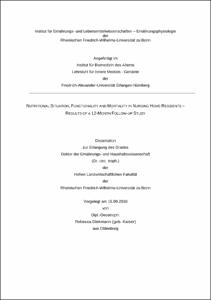Diekmann, Rebecca: Nutritional Situation, Functionality and Mortality in Nursing Home Residents : Results of a 12-Month Follow-Up Study. - Bonn, 2011. - Dissertation, Rheinische Friedrich-Wilhelms-Universität Bonn.
Online-Ausgabe in bonndoc: https://nbn-resolving.org/urn:nbn:de:hbz:5N-23994
Online-Ausgabe in bonndoc: https://nbn-resolving.org/urn:nbn:de:hbz:5N-23994
@phdthesis{handle:20.500.11811/4709,
urn: https://nbn-resolving.org/urn:nbn:de:hbz:5N-23994,
author = {{Rebecca Diekmann}},
title = {Nutritional Situation, Functionality and Mortality in Nursing Home Residents : Results of a 12-Month Follow-Up Study},
school = {Rheinische Friedrich-Wilhelms-Universität Bonn},
year = 2011,
month = jan,
note = {The influence of the nutritional status on quality of life, functionality, morbidity and mortality in elderly people has been shown in several studies. Elderly people, especially with functional and cognitive deficits, are at high risk of malnutrition, a status of an insufficient intake of macronutrients and micronutrients. Prevalence of malnutrition has been investigated in several studies and depends on the observed setting and the used assessment. Consequently, prevalence rates ranged between 5 and 85%. Several methods for the determination of nutritional status or the risk of malnutrition are available; the present thesis focuses on different assessment of nutritional situation, and its influence on functionality and mortality in an observational longitudinal study. Therefore the first aim of this thesis was to test the agreement of MNA, approached by either using a one-on-one interview with residents of two Nuremberg nursing homes compared to the assessment by nursing staff. We identified a fair agreement and a different value of applicability with the two methods. Applicability was higher in the approach of the nursing staff. Additionally, a predictive value of the screening tool could be shown, as residents with a nutritional status identified as “poor” died more often within a one-year follow-up than residents identified as “well-nourished”. Second aim was the description of specific nutrient blood markers of the nursing home residents as another indicator of nutritional status. This included the monitoring within one year and the analysis of its association to functionality and mortality. Longitudinal data on nursing home residents in this regard are not yet available. The highest deficiency prevalence was observed for vitamin D, retinol and albumin. Within one year, status of vitamin D and retinol decreased significantly. Vitamin D, retinol and folate status were associated with functional parameters; vitamin D status was significantly associated with survival. Beside the high prevalence of malnutrition in the elderly, a growing amount of obesity was revealed, including the above 65-year-olds. The discussion on the influence of obesity on functional parameters in the aged has been contradictory. Data on nursing home residents in this regard are scarce anyway. In several studies in different settings, the lowest mortality has been shown to be in overweight and obese elderly. Consequently, the third aim of the present thesis was to investigate the association of obesity, defined as BMI above 30 kg/m2, with functionality and mortality in obese nursing home residents. Obese residents showed the highest levels of the observed functional parameters and the lowest mortality in comparison to residents with low and normal BMI.},
url = {https://hdl.handle.net/20.500.11811/4709}
}
urn: https://nbn-resolving.org/urn:nbn:de:hbz:5N-23994,
author = {{Rebecca Diekmann}},
title = {Nutritional Situation, Functionality and Mortality in Nursing Home Residents : Results of a 12-Month Follow-Up Study},
school = {Rheinische Friedrich-Wilhelms-Universität Bonn},
year = 2011,
month = jan,
note = {The influence of the nutritional status on quality of life, functionality, morbidity and mortality in elderly people has been shown in several studies. Elderly people, especially with functional and cognitive deficits, are at high risk of malnutrition, a status of an insufficient intake of macronutrients and micronutrients. Prevalence of malnutrition has been investigated in several studies and depends on the observed setting and the used assessment. Consequently, prevalence rates ranged between 5 and 85%. Several methods for the determination of nutritional status or the risk of malnutrition are available; the present thesis focuses on different assessment of nutritional situation, and its influence on functionality and mortality in an observational longitudinal study. Therefore the first aim of this thesis was to test the agreement of MNA, approached by either using a one-on-one interview with residents of two Nuremberg nursing homes compared to the assessment by nursing staff. We identified a fair agreement and a different value of applicability with the two methods. Applicability was higher in the approach of the nursing staff. Additionally, a predictive value of the screening tool could be shown, as residents with a nutritional status identified as “poor” died more often within a one-year follow-up than residents identified as “well-nourished”. Second aim was the description of specific nutrient blood markers of the nursing home residents as another indicator of nutritional status. This included the monitoring within one year and the analysis of its association to functionality and mortality. Longitudinal data on nursing home residents in this regard are not yet available. The highest deficiency prevalence was observed for vitamin D, retinol and albumin. Within one year, status of vitamin D and retinol decreased significantly. Vitamin D, retinol and folate status were associated with functional parameters; vitamin D status was significantly associated with survival. Beside the high prevalence of malnutrition in the elderly, a growing amount of obesity was revealed, including the above 65-year-olds. The discussion on the influence of obesity on functional parameters in the aged has been contradictory. Data on nursing home residents in this regard are scarce anyway. In several studies in different settings, the lowest mortality has been shown to be in overweight and obese elderly. Consequently, the third aim of the present thesis was to investigate the association of obesity, defined as BMI above 30 kg/m2, with functionality and mortality in obese nursing home residents. Obese residents showed the highest levels of the observed functional parameters and the lowest mortality in comparison to residents with low and normal BMI.},
url = {https://hdl.handle.net/20.500.11811/4709}
}






